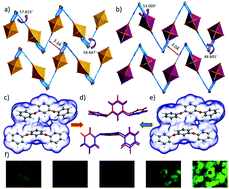当前位置:
X-MOL 学术
›
Chem. Commun.
›
论文详情
Our official English website, www.x-mol.net, welcomes your
feedback! (Note: you will need to create a separate account there.)
Phase transition triggered aggregation-induced emission in a photoluminescent uranyl–organic framework
Chemical Communications ( IF 4.3 ) Pub Date : 2017-12-19 00:00:00 , DOI: 10.1039/c7cc09594e Xia Wang 1, 2, 3, 4 , Yanlong Wang 1, 2, 3, 4 , Xing Dai 1, 2, 3, 4 , Mark A. Silver 1, 2, 3, 4 , Wei Liu 1, 2, 3, 4 , Yuxiang Li 1, 2, 3, 4 , Zhuanling Bai 1, 2, 3, 4 , Daxiang Gui 1, 2, 3, 4 , Lanhua Chen 1, 2, 3, 4 , Juan Diwu 1, 2, 3, 4 , Ruhong Zhou 5, 6, 7, 8, 9 , Zhifang Chai 1, 2, 3, 4 , Shuao Wang 1, 2, 3, 4
Chemical Communications ( IF 4.3 ) Pub Date : 2017-12-19 00:00:00 , DOI: 10.1039/c7cc09594e Xia Wang 1, 2, 3, 4 , Yanlong Wang 1, 2, 3, 4 , Xing Dai 1, 2, 3, 4 , Mark A. Silver 1, 2, 3, 4 , Wei Liu 1, 2, 3, 4 , Yuxiang Li 1, 2, 3, 4 , Zhuanling Bai 1, 2, 3, 4 , Daxiang Gui 1, 2, 3, 4 , Lanhua Chen 1, 2, 3, 4 , Juan Diwu 1, 2, 3, 4 , Ruhong Zhou 5, 6, 7, 8, 9 , Zhifang Chai 1, 2, 3, 4 , Shuao Wang 1, 2, 3, 4
Affiliation

|
When exposed to water, the two-dimensional uranyl–organic layered compound [(CH3)2NH2][(UO2)(BCPBA)]·2DMF·H2O (H3BCPBA = 3,5-bis (4′-carboxylphenoxy) benzoic acid) gradually undergoes a complete single-crystal-to-single-crystal phase transition to [(CH3)2NH2][(UO2)(BCPBA)]·3.4H2O, resulting in an enhanced ligand–ligand interaction between the adjacent layers. This process gives rise to initial quenching of the uranyl photoluminescence followed by subsequent recovery of the photoluminescence with a much elevated intensity, as a unique case of aggregation-induced emission in an extended solid system, further confirmed by DFT analysis on bonding.
中文翻译:

相变在光致发光的铀酰-有机骨架中引发聚集诱导的发射
当暴露于水中时,二维的铀酰-有机层状化合物[(CH 3)2 NH 2 ] [(UO 2)(BCPBA)]·2DMF·H 2 O(H 3 BCPBA = 3,5-bis(4 '-羧基苯氧基)苯甲酸)逐渐经历一个完整的单晶至单晶相转变为[(CH 3)2 NH 2 ] [(UO 2)(BCPBA)]·3.4H 2O,导致相邻层之间的配体-配体相互作用增强。该过程引起了铀酰光致发光的初始淬灭,随后以大大提高的强度恢复了光致发光,这是在扩展的固体系统中聚集诱导的发射的独特情况,通过结合的DFT分析进一步证实了这一点。
更新日期:2018-01-16
中文翻译:

相变在光致发光的铀酰-有机骨架中引发聚集诱导的发射
当暴露于水中时,二维的铀酰-有机层状化合物[(CH 3)2 NH 2 ] [(UO 2)(BCPBA)]·2DMF·H 2 O(H 3 BCPBA = 3,5-bis(4 '-羧基苯氧基)苯甲酸)逐渐经历一个完整的单晶至单晶相转变为[(CH 3)2 NH 2 ] [(UO 2)(BCPBA)]·3.4H 2O,导致相邻层之间的配体-配体相互作用增强。该过程引起了铀酰光致发光的初始淬灭,随后以大大提高的强度恢复了光致发光,这是在扩展的固体系统中聚集诱导的发射的独特情况,通过结合的DFT分析进一步证实了这一点。











































 京公网安备 11010802027423号
京公网安备 11010802027423号